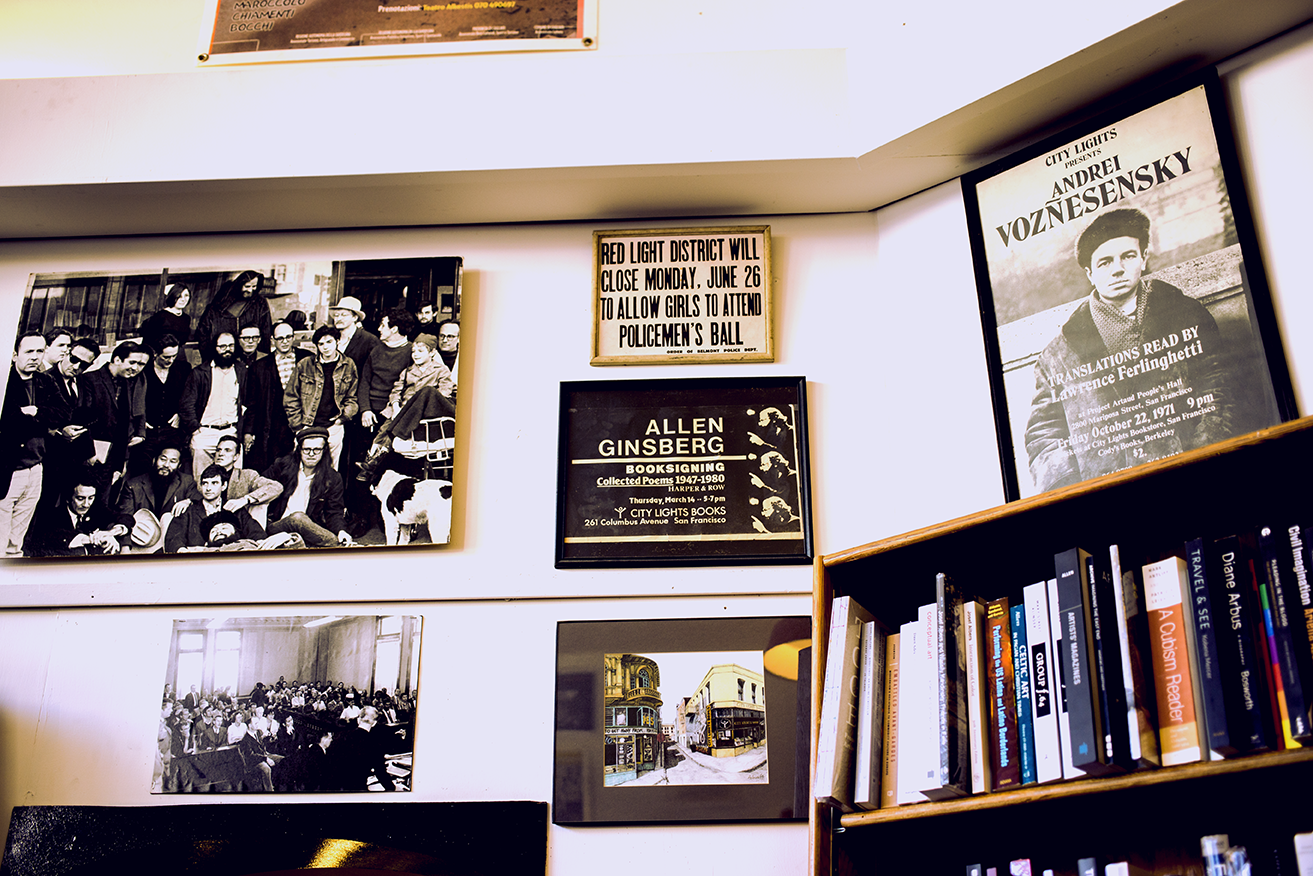City Lights
The North Beach neighbourhood of San Francisco has pretty much been the lifeline of Beat generation activity in the city since the 1950s and 1960s. At the centre of this important American countercultural movement on the West coast was an independent publishing house and bookstore, thriving to this day, called City Lights.
Turn Left
If the fact that it takes its name from a famous Charlie Chaplin movie doesn’t give you a sense of its socio-political outlook, then perhaps the signs hanging in its first-floor windows will. Hand-drawn by the bookshop’s co-founder, the poet and painter Lawrence Ferlinghetti himself, the signs implore the approaching visitor to enter with an “open mind” and “open heart”, and also, of course, to “disarm” and “turn left”.
Sell Phone
If the liberal aura exuded from the building hasn’t thrown you off (you are a book lover, after all), you get closer and stand at the shop-windows for your next set of instructions. Once again, in Ferlinghetti’s hand, you are asked, among other things, to “abandon all despair”, stash your “sell phone” away, and proceed educating yourself on three floors’ worth of books.
Starving Hysterical Naked
In 1957, two years after Allen Ginsberg read his poem, Howl, at Gallery Six, and a year after City Lights published this work, the folks who ran the bookstore and press found themselves at the centre of a remarkable controversy. Howl and Other Poems was considered an obscene volume that had potential to corrupt America’s youth. As publisher, Ferlinghetti stood trial at the nearby Hall for Justice (housed in a building that is now part of the Hilton hotels), where he defended Ginsberg’s work, and its literary and social significance. In a landmark judgement, which ruled that the poem had a redeeming social value, the publication of Howl would set a legal precedent in the fight against censorship in literature. Today, City Lights still publishes Howl and Other Poems with the original 1956 cover. This iconic image can now also be found on some of the bookshop’s official merchandise.
Rebel People
But wait. We do not enter the bookshop yet. Instead, we peer into the narrow lane to its left. Once an inconspicuous, garbage-strewn alley, Adler Place was renamed Kerouac Alley in 2007, largely due to the efforts of Ferlinghetti. As pictured below, on either side of this 50-m-strip stand City Lights and Vesuvio Cafe, the notorious watering hole for the members of the Beat generation. The walls of both the pub and the bookstore are plastered, respectively, with snippets of poems and scenes from the 1990s uprising in a Mexican state. The City Lights mural, specifically, depicts the rural life in the Chiapas region of Mexico, juxtaposed against images of armed men in masks. It is inscribed with the powerful injunction, in both Spanish and English, “Un pueblo con memoria es un pueblo rebelde” (“A people with a memory is a rebel people.”)
All Characters in Bookstore are Real

It is easy upon entering the bookshop to get lost in the labyrinth of shelves. One room leads to another. There are doors within door, and at the end of those, the stairs. On the walls hang old photographs, framed announcements for long-expired events, and, of course, more hand-lettered signs by Ferlinghetti. “Democracy is not a spectator sport,” reminds one.
The Basement
The City Lights basement houses a large collection of non-fiction on subjects ranging from history, economics, women’s studies to music, cinema, print culture, and so on. For its more rabble-rousing customers, the staff has helpfully labelled the relevant shelves as “class war”, “anarchism”, or “muckraking”. This isn’t at all odd when you consider who the basement’s most famous haunters were, back in the day—Allen Ginsberg, Jack Kerouac, and Neal Cassady, among others. Ferlinghetti stumbled upon the basement quite by chance when he decided to poke around some loose floorboards in the store one day. Under them, he found the notorious creature that he later wrote about in his poem, “The Great Chinese Dragon”. The ancient dragon (the first of its kind to cross the Pacific and the same one that “ate all the shrimp in San Francisco Bay”) was said to, until then, lay low in the basement all year, except during Chinese New Year, when it was paraded around Chinatown. The basement was also once the meeting place of a Christian sect. That explains why its walls are plastered with snippets of Biblical verse (“I am the door”, proclaims one).
Have a Seat, Read a Book
That the merchandisers at City Lights have an eclectic taste would surprise no one. A section on the ground floor is stocked with a wide selection of writings from Africa, Latin America, Asia, the Caribbean, and so on. But what City Lights is known for the most is perhaps its poetry room. In addition to hosting the largest collection of poetry in a bookshop, this upstairs room is a nook for lovers of the form. Here, you will find poets and readers, in varying degrees of literary intoxication, reclining on chairs whilst perusing an anthology of their choosing, hovering over displays, and turning over shelved volumes. Reading is not only encouraged in this bookshop, it is enabled.
No comments:
Post a Comment